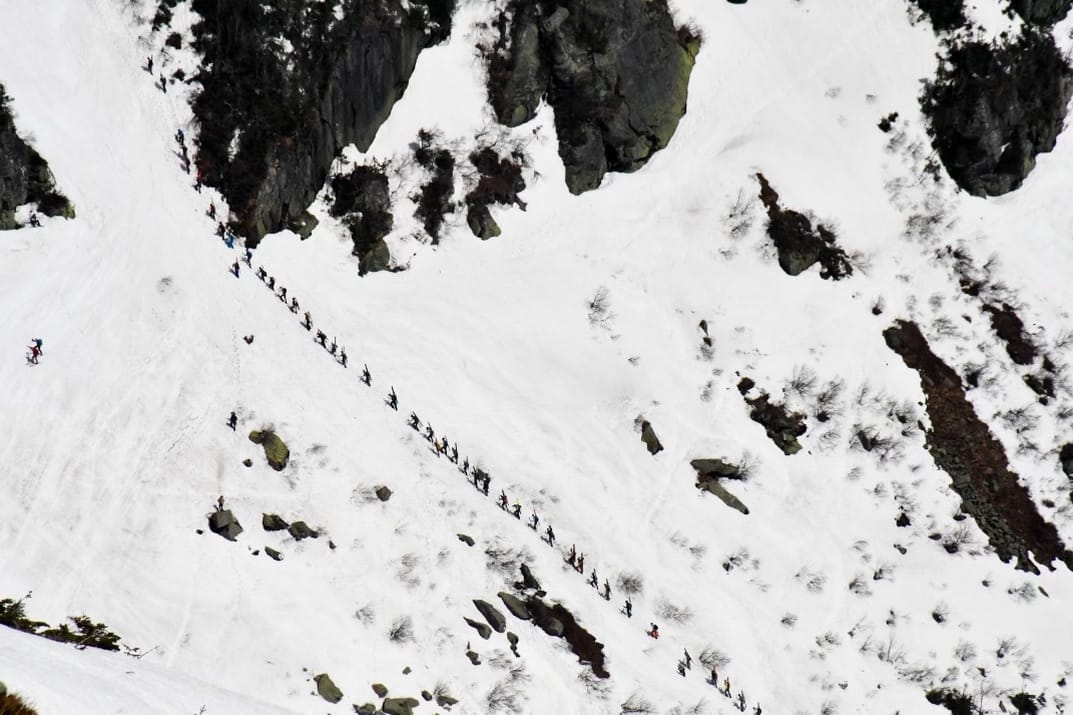Inter-Party Avalanche Involvements: There is a generally accepted and often repeated assumption that the backcountry is overrun with humans. To say the backcountry is a swarming hive of reckless and adaptable bipeds, each caught in their cascade of heuristic traps, is overreach. But there are crowds.
Inter-Party Avalanche Involvements May Increase Quadratically With Party Density is the heady title of Charlie Hagedorn’s paper. Don’t be scared away; there are nuggets to glean. There is a generally accepted and often repeated assumption that the backcountry is overrun with humans. And although the paper was published in 2019, a timewarp since the pandemic evidently sent the hordes of folks emptying shelves of touring gear and into the wilds. Are there more of us out there? Let’s assume so.
The idea of party density and the reality of managing autonomous groups touring in the same zone, and often on the same run, is a real dynamic. To say the backcountry is a swarming hive of reckless and adaptable bipeds, each caught in their cascade of heuristic traps, is overreach. But there are crowds. And by crowds, when the consequences might mean getting caught in a slide caused by an individual outside your group, that can mean a lone solo skier eyeing the same line. As the paper’s title suggests, proximity to other groups in the backcountry might make you more prone to being involved in an avalanche.
Hagedorn dedicates the paper’s research and findings to Monty Busbee, a solo skier killed in an avalanche on Kendall Peak in the Snoqualmie Pass zone outside Seattle. Although inconclusive, there’s a likelihood Busbee was buried in a slide triggered by another group. This is one example Hagedorn cites to make his case: we should take increased group density seriously. Which we should.
Beyond noting an increased number of skiers, Hagedorn provides some keen observations relating to the real or perceived higher density of skiers and why density changes on any given day. There are storm days when we gravitate towards already set skintracks into already limited terrain, days already associated with increased avalanche risk. There’s also the dynamic of seeking optimal conditions in a limited time frame. “Mountains and routes offer only certain optimal times for passage,” Hagedorn writes. “In the Cascades, and perhaps everywhere, this can be seen prominently in periods of spring/summer skiing; both snowpack and limited access curtail skiing at other times.”
Where are we headed? Is the backcountry doomed to cluster- &^%- ery? We’re cautiously optimistic this is not the end game.
Hagedorn suggests several solutions to mitigate increased group density, like finding new terrain, just a bit further back, off the daily run lists for most, to travel in less crowded (read less group dense) terrain. Encourage the use of radios for inter-group comms, and for skiers to possibly adopt communication practices similar to what we hear in climbing, where accepted terms like “on rappel” or “off rappel” are standard devices clarifying the who, what, and where of a situation.
While reading Hagedorn’s findings, I did as I often do; I went down the rabbit hole of footnotes. A 2012 incident on Taylor Mountain off Teton Pass is referenced several times. This is not to rehash what became divisive in the local community over a decade ago but to revisit an old lesson that none of us needs to learn firsthand in the backcountry. No one was hurt or killed when a solo (and experienced) skier triggered a massive avalanche. Undoubtedly luck played a part in the no-casualty outcome of the slide. It stands as a reminder that lives can get snuffed out instantly.
The cosmic intersections of lives in the backcountry can have many outcomes—maybe this is a time to check out quantum mechanics. We all can agree we want those outcomes to skew positive. Yet, there’s another example of a messy situation I’ve thought about in the ensuing 1.5 years; an incident in the Teton’s Sliver Couloir. (The Fine Line podcast did a nice job of exploring the incident in episode 42, The Downfall of Miscommunication.)
One takeaway, for me, about the Sliver incident is certainly the lack of communication between the parties. The other is seeing each person in the backcountry as someone who may have a partner to go home to, a child to tuck in that evening, let alone a dog (or cat) back home that needs to pee. I’m saying that each one of us has some yarns woven into a deep-life fabric.
The other option is to see others out in a high density area as features in a landscape. Something to be tolerated, something that maybe sullies the view, but that’s all.
Be a good partner, and be aware of the groups around you—this is all an aspect of the heightened situational awareness you need in avalanche terrain. This is even more critical in the situations Hagedorn describes.
Although backcountry skiing is not a chess match where you outduel and out-strategize your opponent, if you are not directly communicating with other groups in a group-dense zone, you must effectively strategize like a chess player and see moves in advance. That is a big ask for anyone, as humans and snow slopes can be unpredictable.


A really good point to think about Jason!
This is a major problem in the Central Wasatch. With over two million people living along the Wasatch Front we are likely the most urbanized mountain range in the west. It is absolute chaos on a sunny weekend powder day. Standard (“safe”) ascent routes have become a thing of the past; it is shocking to be skiing deep powder in a tight couloir with low angle access on the backside, only to come around a corner and see a large group clown-shoeing up the avalanche path below you.
Interparty close calls have become commonplace. Four people from two different groups were killed in a tragic accident in 2021. With the poor terrain management/decision making we witness on a daily basis, I think it is only a matter of time before we see another accident of this magnitude, or something worse. Basic, standard (or what used to be standard) practices like not dropping in above another skier, minimizing time exposed to avalanche hazard, and ascending avalanche resistant terrain could help mitigate this risk. Unfortunately nobody seems interested in any of that and you have to assume, where ever you are, that there is a group faffing around below (or above) you. It would be nice to see a culture shift in this regard but it seems unlikely in our community at this point. Style and ethics matter.
The-High-Route is sweet. I wish it was free, but this article and a few others convinced me that it is worth the money.